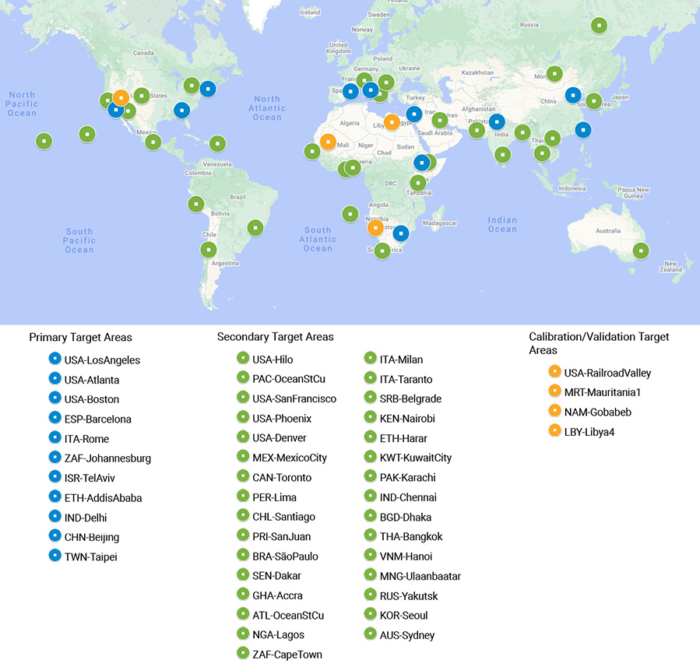In collaboration with NASA, USAID is supporting the development of next generation technology that will significantly move forward the science of using satellite data to capture concentrations and classes of fine particulate matter. USAID’s assistance is specifically to fill a gap in the ground sensor networks in Ethiopia and South Africa – two MAIA Primary Target Areas where the ground sensor networks were least developed and where funding was needed the most. USAID’s support ensured inclusion of the African continent in the project, where air pollution is a growing challenge but understudied compared to other regions.
Status:
Active
Region:
Africa
Country:
Ethiopia
South Africa
Key Documents:
- [Project Poster] In-Situ Particulate Matter Monitoring in Ethiopia: Spatial and Temporal Trends of Ambient PM2.5 and Black Carbon
- [Presentation] NASA's Multi-Angle Imager for Aerosols Investigation in Africa: An Integrated Satellite and Surface Monitoring Approach for Mapping Speciated Particulate Matter Air Pollution
Issues:

Overview
Exposure to airborne particulate matter (PM) is the top environmental health risk worldwide and has been associated with more than 4 million deaths per year, cardiovascular and respiratory disease, low birth weight, lung cancer, and other adverse health outcomes. However, linkages between particulate matter particle characteristics (size, shape, and composition) and health remain poorly understood. The goal of NASA’s Multi-Angle Imager for Aerosols Earth Venture Instrument (MAIA-EVI) investigation is to enable health studies in regions impacted by different levels, types, and sources of particulate matter pollution. The investigation represents the first time NASA has partnered with epidemiologists and health organizations on a satellite mission to study human health and improve lives.
In collaboration with NASA, USAID is supporting the development of next generation technology that will significantly move forward the science of using satellite data to capture concentrations and classes of fine particulate matter. Since many Low and Middle Income Countries do not have the resources or expertise to monitor air pollution, this effort can help fill an important gap that currently hinders action on air pollution. The MAIA team has currently identified 11 globally distributed Primary Target Areas for detailed study of the concentrations and chemical composition of particulate matter and its impacts on human health. In these areas – located in the U.S., Europe, Middle East, Asia and Africa – MAIA satellite data will be combined with PM data from ground instruments to generate concentration maps of ambient particles and its major chemical components. The mission plans to deploy the MAIA instrument within the next two years aboard a spacecraft contributed by the Italian Space Agency (ASI), with an anticipated launch in late 2024.
USAID’s assistance is specifically to fill a gap in the ground sensor networks in Ethiopia and South Africa – two MAIA Primary Target Areas where the ground sensor networks were least developed and where funding was needed the most. USAID’s support ensured inclusion of the African continent in the project, where air pollution is a growing challenge but understudied compared to other regions. USAID’s support to MAIA is provided through the existing NASA/USAID SERVIR partnership that helps participating countries use satellite data and geospatial technology to address development challenges related to climate risk and land use.

Ground Sensor Network
In Ethiopia, the MAIA-EVI project has deployed and is operating a variety of in-situ PM sensors in Addis Ababa and Adama. These include an AirPhoton SS5 PM2.5 sampling station as part of the international Surface Particulate Matter Network (SPARTAN) for PM2.5 speciation, two Colorado State University Aerosol Mass and Optical Depth (AMOD) monitors to provide additional PM2.5 speciation measurements, two AethLabs microAeth MA350 monitors for black carbon monitoring, and 11 PurpleAir-II-SD sensors for total PM2.5 measurements that complement the PM2.5 monitoring done at US Embassy sites. The near real-time PM2.5 measurements taken by the PurpleAir sensors and reference monitors at the Embassy sites can be accessed through the following links:
The speciation data will be publicly available at NASA’s Atmospheric Science Data Center in the near future.
In South Africa, two SPARTAN SS5 and one AMOD are supporting the MAIA-EVI investigation, along with total PM2.5 measurements acquired by the South African Air Quality Information System (SAAQIS).
The location of the above mentioned PM sensors, along with additional information about the MAIA target areas, can be found on this interactive map.
Health Studies
The majority of air quality studies conducted in Africa, particularly in Ethiopia, have been short-term and limited in scope, making it difficult to fully understand the sources and characteristics of PM pollution and its impact on human health. The MAIA mission addresses this limitation by beginning a comprehensive in-situ PM monitoring with research-grade monitors nearly two years before the satellite launch and continuing through the end of the mission (around 2027). This long-term monitoring of PM and its chemical components, in conjunction with the satellite data products and epidemiological results that will become available after launch, will allow for a better understanding of the composition, sources, and spatiotemporal trends of ambient PM and provide new information for policymakers and public health officials.
The MAIA-EVI epidemiological study plans for Ethiopia include investigations of the association between exposure to ambient PM and sub-chronic health effects, such as preeclampsia, low birth weight, and child mortality in Addis Ababa, as well as chronic health effects, including respiratory morbidity, lung function, and cognition in Adama. In South Africa, planned MAIA-EVI epidemiological studies will examine acute health effects such as cause-specific mortality due to ischemic heart disease, stroke, pneumonia, and diabetes.
Expected Outcomes
The expected outcomes of the USAID-NASA collaboration on MAIA are to:
- Operate specialized air quality equipment to monitor different constituents of fine particulate matter and establish sustainable operations after the MAIA mission is completed.
- Explore the effects of mixtures of particulate matter pollution on cause-specific mortality, cognition, preeclampsia, low birth weight, and childhood respiratory morbidity.
- Inform air quality and public health organizations, universities, science councils, and other stakeholders in Africa about PM exposure.
- Prepare teaching materials and hold training workshops to instruct researchers in Africa how to access, browse, visualize, and utilize MAIA data products.
- Coordinate with SERVIR on the positioning of secondary target areas in Africa to complement the Ethiopia and South Africa primary targets.
Key Links
- Getting to the Heart of the (Particulate) Matter: NASA’s MAIA to Study How Particulate Matter Air Pollution Affects Our Health
- Using Satellite Data to Map Air Pollution and Improve Health
- Breaking New Ground: Space Agencies and Epidemiologists Partner Up on Particulates


